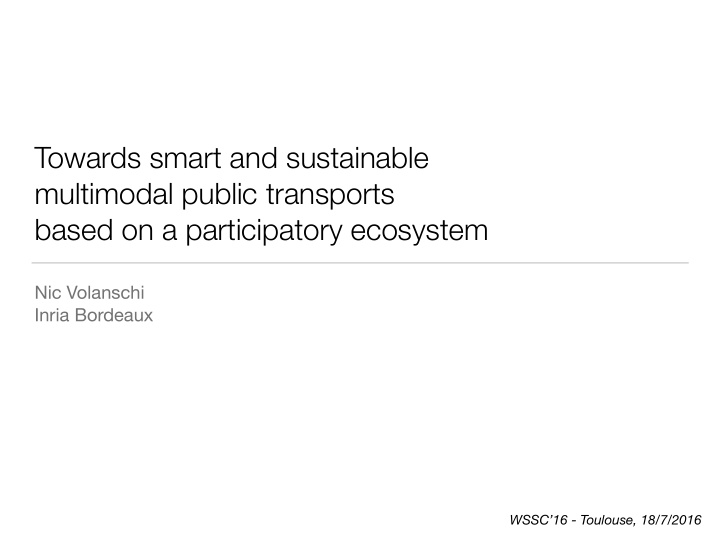



Towards smart and sustainable multimodal public transports based on a participatory ecosystem Nic Volanschi Inria Bordeaux WSSC’16 - Toulouse, 18/7/2016
Outline • Public transport applications • Consumer vs participatory assistants • Benefits of a participatory ecosystem • Conclusion & future challenges 2
Public transport applications mobile computing + open data (RT) + Bicycle Sharing Systems Contextual assistants: Static trip planners • step-by-step guiding • notifications about incidents
Consumer assistive app Open data Ongoing trip Posi,on Ideal trip 4
Participatory assistive app Ideal trip Posi.on Ongoing trip ID Smarter Infrastructure planning Greener assistance Smarter resource management Smarter incident bypassing 5
Green assistance scenarios ideal trip ongoing trip ID = TicketNo App notifications 6
Green assistance scenarios ideal trip ongoing trip ID = TicketNo + phoneNo SMS notifications 7
Green guidance benefits Owns a mobile phone Owns a smartphone Installs assistive app Data connection Keeps app on GPS on … 8
The VIP prototype • State-of-the-art assistive app • enhanced for providing user data • Server part • monitors tra ffi c incidents • alerts BSS operator on resource shortages • TBD: integrate real operator, test optimization actions 9
Conclusion • Participatory apps go beyond community-based apps • leverage operator’s sensors infrastructure • feed (anticipated) information guiding operator’s actions • provide direct measure of missing operator’s resources • Remaining challenges • User acceptance • Inter-operability and long-term maintenance • Established simulation testbed 10
Thanks!
Driving factors in transport planners 2007: iPhone 1 2009: Android 1.0 Transport planners 2004: OECD declaration 2009: data.gov 2005: Velo’v (Lyon) 2007: Velib (Paris) 2015: 800+ BSSs
Assistive transport apps: Limitations • Consumer-only model • consume open data & aggregate it with user data • Perform redundant computations (based on GPS) • Transporter cannot use useful user data • intended destination, trip schedule • future resource needs • current position • ideal trip (if unfeasible)
Participatory optimizations • Greener assistance • Turn the GPS off • Navigate offline • Use any cellphone • Smarter resource management (BSS) • Smarter incident bypassing • Smarter infrastructure planning
Future work • Measure scalability of server side (Hist) • DiaSuite server / DiaSwarm server • Measure resource anticipation times (Hist) • Compare “exact” vs. predicted needs (Sim) • Test effectiveness of rebalancing actions (Hist/Real) • Measure user acceptance (Quest) • Measure user satisfaction (Real)
Recommend
More recommend